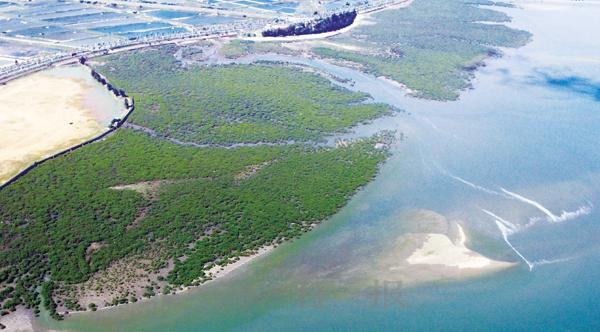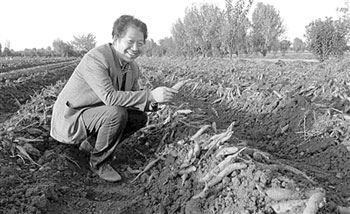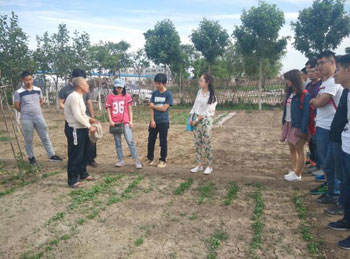Behind the increase of 65% in 14 years

Golden Bay mangroves. Photo taken by our reporter Li Junguang
The forestry department of Beihai City recently revealed that mangroves, which are known as "coastal guards", "marine forests", "bird paradise", "fish and shrimp granaries" and many other viviparous woody plants, are growing well in the Beihai Sea, with a total area increasing year by year. It has grown from 3120 hectares in 2002 to 5158.6 hectares at present, an increase of about 65 percent.
In recent years, the total area of mangroves in the world is decreasing at a rate of more than 0.7% a year. However, over the past 14 years, mangroves in the North Sea have increased rather than decreased, and the total area has increased by nearly 70%. While exploring the mystery, the reporter noticed two true stories about the mangroves in the North Sea.
The first story took place in September 1996. The 15th super typhoon hit Beihai and nearly 300 boats and rafts were sunk by the typhoon at Shatian fishing Port, Hepu County, Beihai City, leaving more than 40 people dead or missing. People were surprised to find that more than 350 fishing boats and crew moored in the tidal ditch of the nearby national mountain pass mangrove reserve were unharmed.
The second story took place in May this year. The Beihai Golden Bay Mangrove Eco-tourism Scenic spot plans to hold the "largest snail digging competition in China". After the news broke, environmental protection groups and many people in the North Sea were acutely aware that the move might bring immeasurable harm to the Golden Bay mangrove ecosystem, so they protested strongly one after another. In the end, the organizers complied with the public opinion and cancelled the competition.
"from the protection object of the 'coastal guard' to the conscious guardian of the 'coastal guard', the environmental protection awareness of the Beihai people is constantly increasing, and the Beihai ecological civilization is making continuous progress." Dr. Fan Hangqing, international expert and chief Chinese expert of the United Nations Environment Programme Global Environment Facility mangrove and director of Guangxi Mangrove Research Center, said in a recent interview that two stories 20 years apart vividly show the virtuous circle of the harmonious symbiosis between the beautiful coastal city of Beihai and the mangroves.
The reporter learned that mangroves are not only the main vegetation species to protect the marine ecological environment, but also the link to maintain the land and sea ecosystem, and play a special role that can not be replaced by terrestrial trees. At present, there are 11 families, 14 genera and 15 species (including 5 semi-mangrove species) of mangrove vegetation in Beihai City, accounting for 34.1% of the 44 mangrove species (including semi-mangrove) in China. The main species are marina, Kandelia Candel, paulownia, red sea olive, wood olive, sea lacquer, halogen fern, olive plum, water yellow bark and so on. The main formations are marina formation, paulownia formation, Mulan formation, red olive formation, sea lacquer formation and Kandelia Candel formation and so on.
Over the years, Beihai City has always regarded mangroves as the key object of protection, adhered to the bottom line of environmental protection in the process of economic development, and adopted a variety of strong protection measures, so that this precious coastal resources can be continuously expanded. All mangrove areas in the city are classified as national ecological public welfare forests, which are included in the scope of national forest ecological benefit protection.
In order to protect the existing mangroves from infringement, after full investigation and scientific demonstration since the 1990s, Beihai City has successively issued the regulations on the Protection and Management of Mangrove forests in Beihai City (1999) and the Circular of the people's Government of Beihai City on strengthening the Protection of Mangrove Resources (2000). Hepu County has also issued the Circular on resolutely stopping indiscriminate felling and destruction of mangroves and the Circular on strengthening the Protection of Mangrove Resources. In order to protect birds in mangrove wetlands, the Beihai government issued the regulations on the Protection and Management of Birds in Beihai City in 1996. With the implementation of these documents, the protection and management of mangroves in our city are further standardized, legalized and institutionalized.
The establishment of protected areas is an important measure to strengthen the protection of Beihai coastal wetland resources. Since the establishment of Weizhou Island Nature Reserve in 1982, our city has established 2 national nature reserves, 6 nature conservation communities and 1 national wetland park. They are Guangxi Shankou Mangrove National Nature Reserve, Guangxi Hepu Dugong National Nature Reserve, Tieshan Port Bailong Ancient City Port Coastal Red Hailan Nature Conservation area, Yinhai District Pingyang Town Henglushan Mangrove Nature Conservation area, Haicheng District Gaode Qixing Mangrove Nature Conservation area, Hepu County Dangjiang Town Mangrove Nature Conservation area, Hepu County Shagang Town Qixing Mangrove Nature Conservation area, Dangjiang Town, Hepu County, Yujiang Mangrove Nature Conservation District and Guangxi Beihai Binhai National Wetland Park. Among them, Guangxi Shankou Mangrove National Nature Reserve has been listed as an internationally important wetland.
Artificial planting of mangroves can slow down the flow rate and promote the restoration of primary mangroves. Since 2002, the forestry department of our city has successively planted more than 14000 mu of mangrove varieties such as paulownia, Kandelia Candel, marina, red sea olive and so on in most coastal towns of Beihai City. After more than a decade of continuous hard work, the area of mangroves in the North Sea has achieved restorative growth, and the ecological environment has also been continuously improved. According to incomplete statistics, there are 124 species of marine animals growing in the mangroves of our city, and 136 species of waterbirds have been recorded.
A good ecological environment is the advantage and competitiveness of Beihai. In October 2013, according to the selection criteria of "whether the value is outstanding, whether the form is typical, whether the species is unique, and whether the protection is favorable", Guangxi Shankou National Mangrove Ecological Nature Reserve was favored by netizens and experts. It was successfully selected as one of the "Top Ten glamorous Wetlands in China".
- Prev

Identify the side effects of chemical fertilizer and praise the bionic green manure.
Identify the side effects of chemical fertilizer and praise the bionic green manure.
- Next

The farmer taught the Nankai students to grow vegetables and opened their horizons.
The farmer taught the Nankai students to grow vegetables and opened their horizons.
Related
- A course of planting techniques and methods on how to grow carrots
- How to plant the latest tulips?
- Is it better to pick tea in the morning or in the afternoon? When is the best time for tea to be picked? what is the third or fifth tea?
- Launch Yuanxiao Happy combination Haocha + Tea Yuan healthy Taste
- Penghu Tourism "Fireworks 20 Parade with You"
- 2022 West Lake Happiness holds "Digital Revitalization Voucher" and draws iphone13 and laptop.
- Banqiao Fuzhou social houses are designed to change start-up combined with police elimination to create a safe and livable environment
- The convenient measure of "mechanical weeding" in Xinbei has been abused and the Agriculture Bureau has imposed heavy penalties on the illegal land consolidation.
- Changgeng University Joins Hands with Four Memory Factories to Rescue Memory Talent Shortage
- The list of Taiwan's top 100 MVP managers is listed by the Director-General of the Farmers' Association of Sanxia District.

